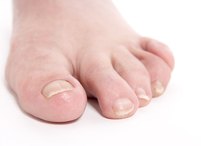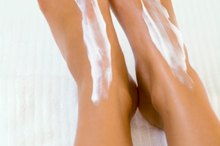What does fact checked mean?
At Healthfully, we strive to deliver objective content that is accurate and up-to-date. Our team periodically reviews articles in order to ensure content quality. The sources cited below consist of evidence from peer-reviewed journals, prominent medical organizations, academic associations, and government data.
The information contained on this site is for informational purposes only, and should not be used as a substitute for the advice of a professional health care provider. Please check with the appropriate physician regarding health questions and concerns. Although we strive to deliver accurate and up-to-date information, no guarantee to that effect is made.
What Causes Nail Fungus to Itch?
Onychomycosis is the medical term for fungal infections of the fingernails and toenails. Infections of the fingernails or toenails can cause irritating symptoms such as pain, redness and itching. Although infections can be caused by yeast and molds, most infections are from a fungus group known as dermatophytes. Itching occurs when the fungus causes irritation and damage to your skin. Factors that allow fungus to proliferate will also lead to an increase in symptoms such as itching.
Fungus Exposure
Environments that are ideal for fungus growth increase the risk of infection through contact. Additionally, frequent contact with individuals with an active fungal infection can also increase the risk of infection. Hand hygiene that consists of both of washing and drying the hands is important in minimizing the risk of infection due to environmental exposure.
Temperature
What Are the Causes of Dry Cracked Hands?
Learn More
Fungus proliferates in warmer temperatures. Warmer climates and body areas that remain covered by clothing such as socks create ideal fungi growth environments. Keeping infected nails dry and cool helps to slow growth, according to MayoClinic.com.
Moisture
Fungi thrive in moisture rich environments. Sources of moisture could include air humidity, wet environments, and body perspiration. Measures taken to avoid trapping moisture and allow air circulation will keep the nails dry and slow fungus growth.
Medical Conditions
Causes of Ringworm in the Genital Area
Learn More
Medical conditions that impair the immune system can allow dermatophytes to proliferate. Diabetes can cause poor circulation to the peripheral areas of the body. Immune disorders and medications that suppress the immune system can also make it more difficult to eliminate nail fungus. Concurrent infections by other organisms can overwhelm the immune system as well as causing additional skin irritation.
- Medical conditions that impair the immune system can allow dermatophytes to proliferate.
- Concurrent infections by other organisms can overwhelm the immune system as well as causing additional skin irritation.
Fungal Treatment
In many cases, antifungal medication is required to eliminate the fungus that causes nail infections. Topical antifungal products are most commonly used but more resistant infections will require oral or intravenous medication. Consult a physician if symptoms of infection appear to avoid delaying treatment. (See References 2)
- In many cases, antifungal medication is required to eliminate the fungus that causes nail infections.
- Consult a physician if symptoms of infection appear to avoid delaying treatment.
- (
Nail Care
Nails should be kept clean, dry, and in good physical condition. Avoid tight fitting shoes and biting the nails, both of which can cause damage and increase the risk of infection. Additionally, nails should be kept properly trimmed and routinely checked for discoloration or other abnormalities, according to the American Academy of Dermatology.
- Nails should be kept clean, dry, and in good physical condition.
Related Articles
References
- Shirwaikar AA, Thomas T, Shirwaikar A, Lobo R, Prabhu KS. Treatment of onychomycosis: an update. Indian J Pharm Sci. 2008;70(6):710-4. doi:10.4103/0250-474X.49088
- Syed TA, Qureshi ZA, Ali SM, Ahmad S, Ahmad SA. Treatment of toenail onychomycosis with 2% butenafine and 5% Melaleuca alternifolia (tea tree) oil in cream. Trop Med Int Health. 1999 Apr;4(4):284-7. doi:10.1046/j.1365-3156.1999.00396.x
- Buck DS, Nidorf DM, Addino JG. Comparison of two topical preparations for the treatment of onychomycosis: Melaleuca alternifolia (tea tree) oil and clotrimazole. J Fam Pract. 1994 Jun;38(6):601-5.
- Chee HY, Lee MH. Antifungal activity of clove essential oil and its volatile vapour against dermatophytic fungi. Mycobiology. 2007;35(4):241-3. doi:10.4489/MYCO.2007.35.4.241
- Gayoso CW, Lima EO, Oliveira VT, Pereira FO, Souza EL, Lima IO, Navarro DF. Sensitivity of fungi isolated from onychomycosis to Eugenia cariophyllata essential oil and eugenol. Fitoterapia. 2005 Mar;76(2):247-9. doi:10.1016/j.fitote.2004.12.005
- National Institutes of Health. "Fungal nail infection: MedlinePlus Medical Encyclopedia". June 2011.
Writer Bio
Jacob Seykans began writing online professionally in 2010. He has been a registered pharmacist for over five years. He has practiced pharmacy in both community and hospital settings. Seykans holds a Doctor of Pharmacy degree from the University of Minnesota.








